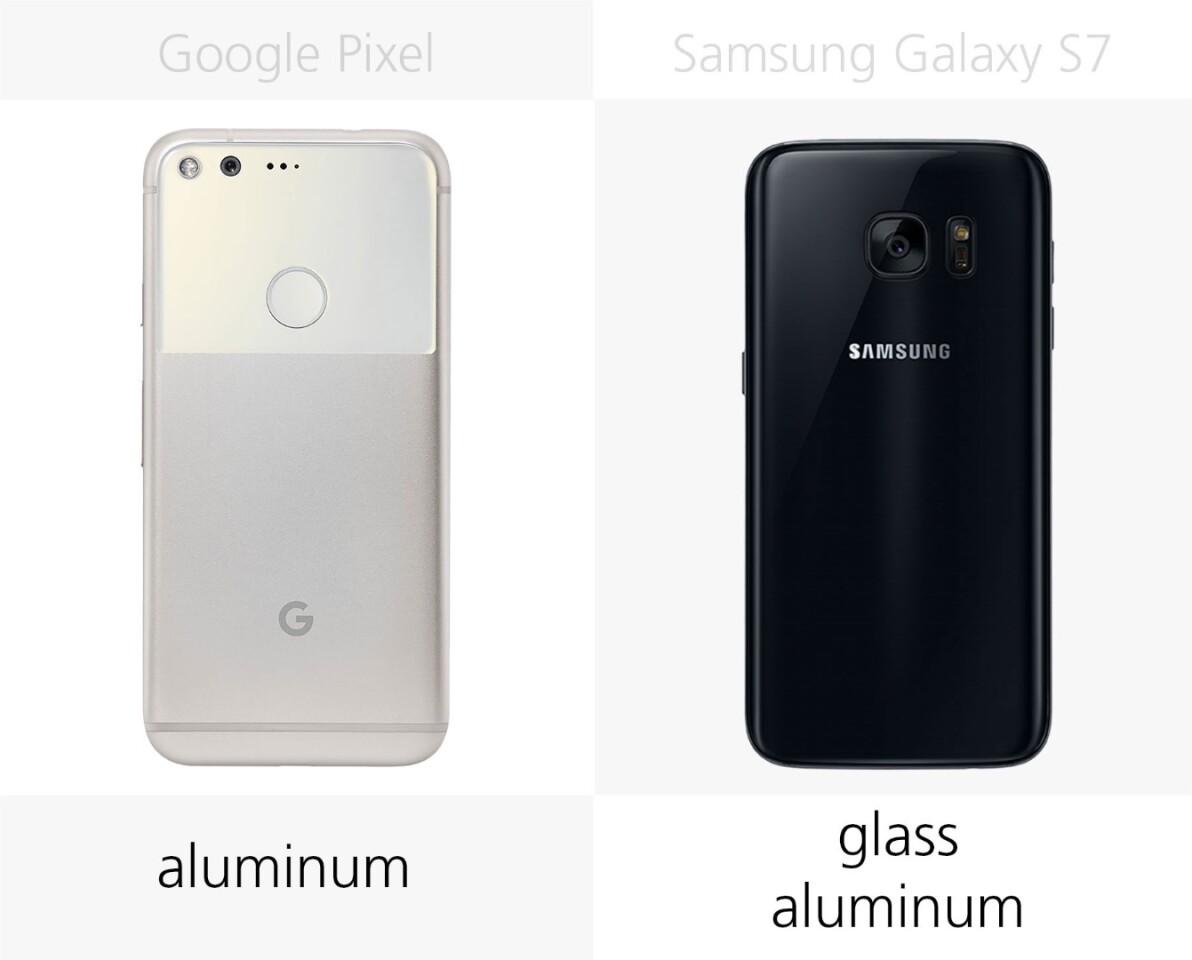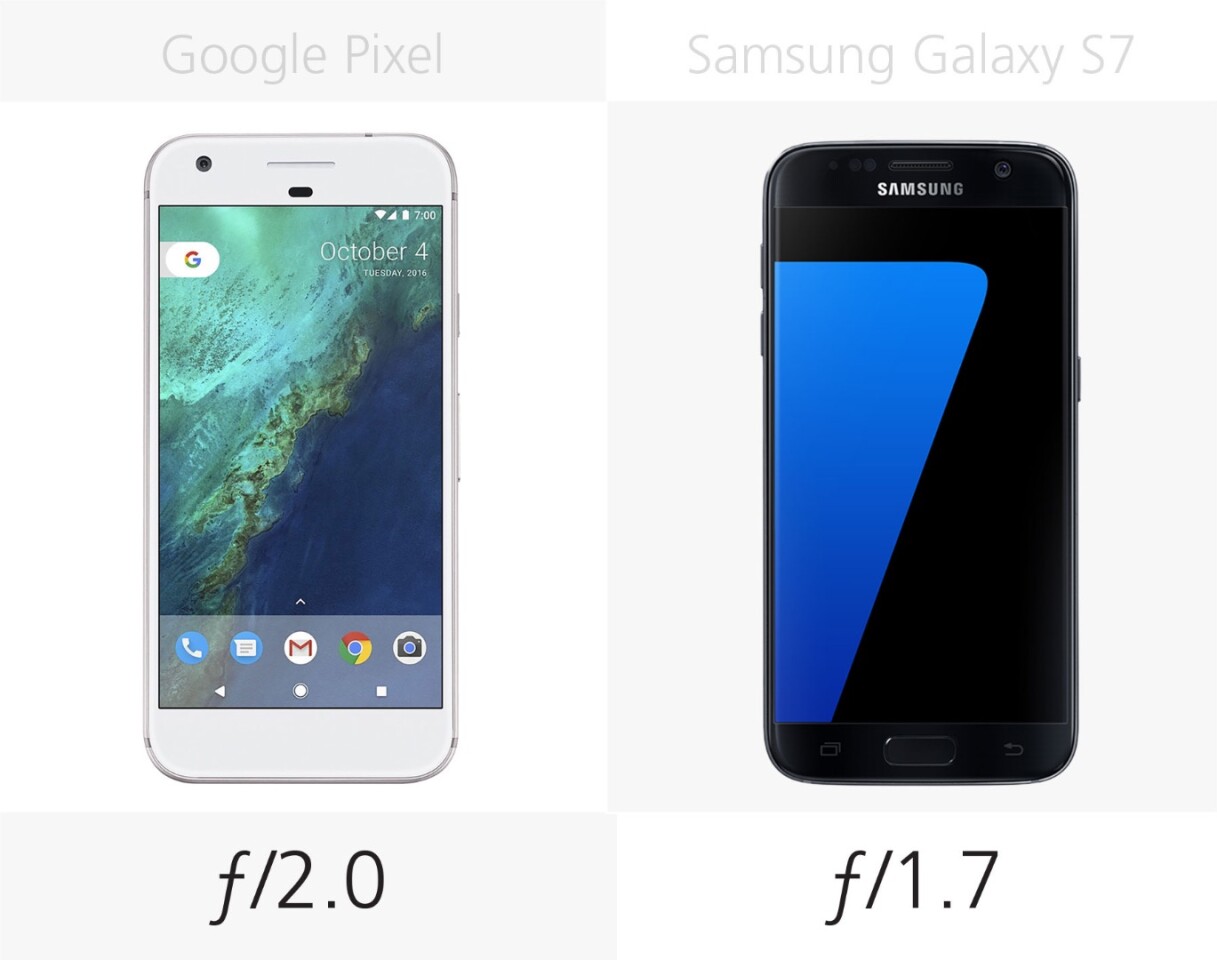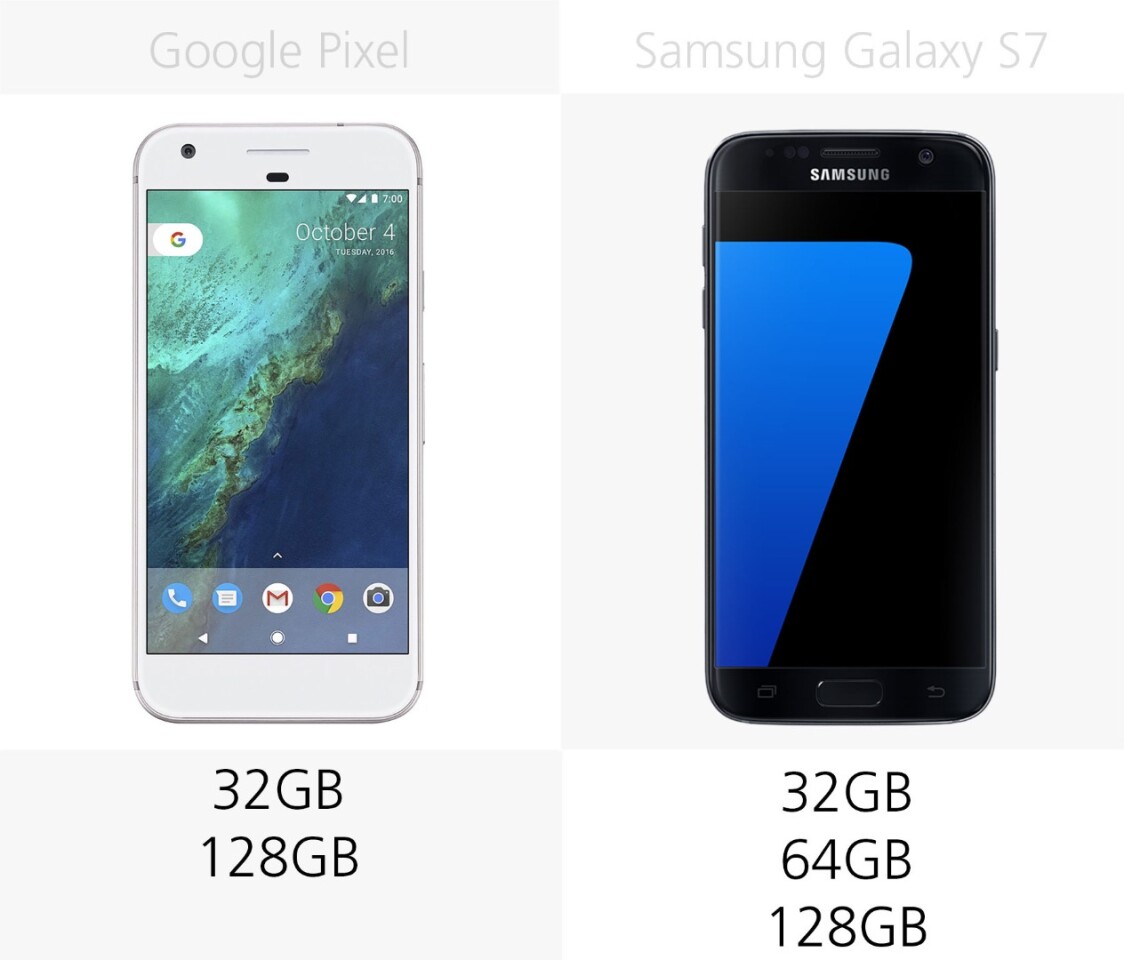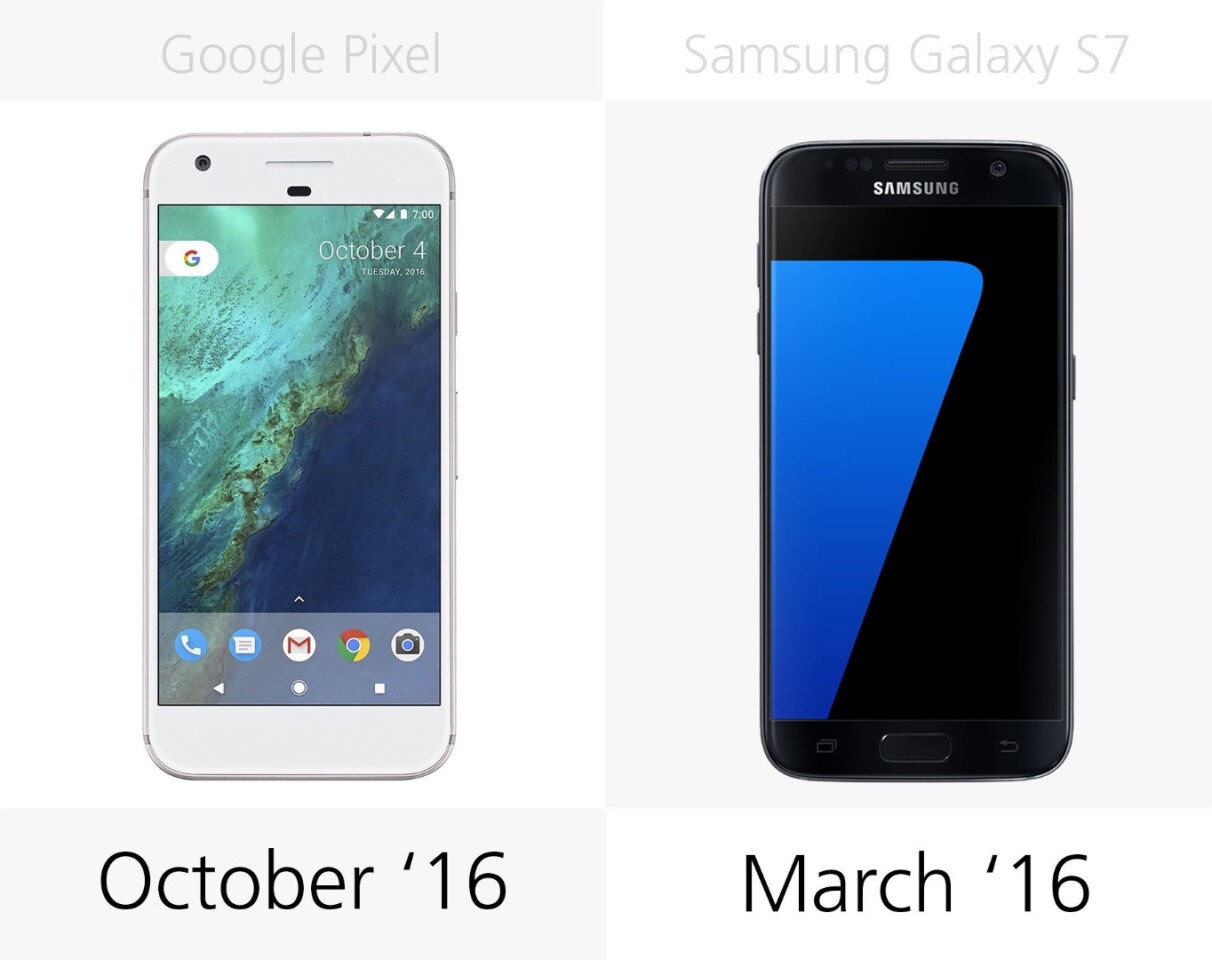While Google is no stranger to smartphone manufacturing (the conglomerate has been overseeing Nexus design and manufacturing for years), the Pixel is the first phone to officially be dubbed "Made by Google." How does the hotly anticipated Pixel compare to its industry-leading Android competitor, the Samsung Galaxy S7?
Size

The two phones have the same width, but the Pixel is just a touch taller and thinner.
Weight

The comparatively squat Galaxy S7 is 6-percent heavier than the Pixel.
Build

When it comes to build, Google sticks with an iPhone-esque aluminum unibody, while Samsung keeps things interesting with slick curvy glass. The minimal aluminum frame nearly disappears into the glass front and back, which earned it major points in our review.
Water resistance

The Galaxy 7 series has industry-leading water resistance. The IP68 rating means the S7 can withstand immersion in up to five feet of water for up to 30 minutes. Unfortunately, the first Google-branded phone offers no such reassurance.
Colors

There are three color variants for each model; both are available in black and silver. In addition, Pixel takes a more colorful route with a blue option, while S7 goes for the gold.
Display size

Even though the S7 is smaller, Samsung manages to sneak a little extra screen (2 percent more) onto its front surface area.
Display resolution

The Pixel's 1,920 x 1,080 display meets the Full HD standard, but its resolution is still dwarfed next to the S7's Quad HD display. The difference might seem like overkill, but we bet that it makes a quite a difference when using mobile VR headsets.
Display type

Both manufacturers fall on the same side of the fence when it comes to using IPS vs. AMOLED display technology.
Curved display

The Pixel has a standard rectangular screen. The Galaxy S7's display hugs the curves of its glass front, curling ever so slightly around the edges of the phone.
Always-on display

We'll be able to confirm this once we perform our full-length review of the Pixel, but for now, it does not seem to have an "always-on" display option like the S7 does. This feature lets you see key notifications at a glance, without having to unlock the phone.
Pressure-sensitive display

Apple has developed a pressure-sensitive display that lets you lightly tap or firmly press the touchscreen for different results, but similar capabilities have yet to come to Android devices. Neither of these phones have a pressure-sensitive display.
Camera megapixels

The two devices have matching rear camera resolution, but with a notable 3-megapixel advantage, the Pixel is the selfie champ.
Camera aperture (rear)

The smaller the f-stop, the larger the aperture. A larger aperture means sharper photos in low light, among other things. S7 beats Pixel in this department.
Optical image stabilization

Optical image stabilization is absent from the Pixel. That means you'll see less noticeable camera shake and consequential photo blur from the OIS-equipped S7.
Dual-lens camera

Unlike the iPhone 7 Plus or the Huawei Honor 8, there are no fancy dual-lens tricks here.
Charging/data port

Pixel uses a more universal USB-C charging/data port, while the S7 uses the smaller microUSB.
Battery

Both phones have fairly large batteries, but the S7 edges out the Pixel. According to Google, a full Pixel charge will get you up to 26 hours of talk time and up to 13 hours of internet use or video playback over Wi-Fi. By Samsung's count, the S7 is good for up to 28 hours of talk time, 13 hours of internet use, or 16 hours of video playback.
Fast charging

Both phones offer the convenience of a quick charge.
Wireless charging

The S7 can be charged wirelessly using a charge pad (sold separately), but not the Pixel.
Processor

The two processors have the same clock speeds, but the Pixel's is a slightly newer version.
RAM

These phones have matching amounts of memory.
Internal storage

Both phones have 32 and 128-gigabyte storage sizes. The S7 also offers an intermediate 64-gigabyte option.
microSD

No matter which size S7 you get, rest assured knowing you'll never run out of space thanks to the phone's microSD expandable storage.
VR headset compatibility

Google's Pixel phones and Samsung's Galaxy 7 series are the leading virtual reality-ready phones on the market. Pixel is Daydream View-compatible; Gear VR is Samsung's offering.
Headphone jack

Be relieved, owners of expensive headphones: Android manufacturers haven't axed the headphone jack yet.
Fingerprint sensor

Fingerprint sensors are practically non-negotiable smartphone features at this point. Google puts its sensor on the back of the Pixel; Samsung's is incorporated into the home button.
Mobile payments

Both phones are equipped for mobile payments. Samsung Pay is supported in more countries, and it's accepted by more merchants within those countries. Why? Samsung Pay can actually mimic the swiping of a magnetic strip in addition to NFC transactions, so merchants shouldn't need any newfangled equipment to accept it.
Virtual assistant

Google Assistant (the newest iteration of Google Now) makes its first appearance on the Pixel and Pixel XL. We have not yet tried out this voice-activated virtual assistant for ourselves, but it is shaping up to be a more powerful alternative to the Google Now/S Voice features on the Galaxy S7.
Operating system

As Google's first real flagship, Pixel will launch running the absolute latest version of its operating system, Android 7.1 Nougat. Google has said Pixel will be on the forefront of new updates for the next two years and will receive security updates for three years.
As of now, the Galaxy S7 is running Android Marshmallow with Samsung's proprietary TouchWiz skin. In the past, Samsung has taken 5-6 months to roll out its customized updates, which would place the Nougat update sometime in the beginning of 2017.
Release

The recently launched Pixel is the newcomer to the market. The S7 was released earlier this year.
Starting price (full retail)

Samsung prices vary depending on carrier and payment plan, but you'll likely pay about US$20 more for a Galaxy S7 over Google's Pixel. However, the Samsung flagship's specs sneak past Google's in a number of areas. The extra cash could be well worth it, particularly if you're drawn to its glass build, water resistance, expandable storage, or the versatility of Samsung Pay.
Still, as the first "made by Google" phone, Pixel could offer a cohesive software and hardware experience not seen in other Android phones. We're also excited to see how the Daydream View experience compares to that of the Gear VR.
We'll post a full length review of the Pixel once the phones ship. Until then, read up on what the Galaxy S7 has to offer, or check out News Atlas' comparisons of the Pixel and iPhone 7, or the Pixel XL and iPhone 7 Plus.


